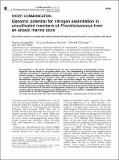| dc.contributor.author | Ulloa, Osvaldo | |
| dc.contributor.author | DeLong, Edward Francis | |
| dc.contributor.author | Astorga-Elo, Marcia | |
| dc.contributor.author | Ramirez-Flandes, Salvador | |
| dc.date.accessioned | 2016-03-02T18:30:34Z | |
| dc.date.available | 2016-03-02T18:30:34Z | |
| dc.date.issued | 2015-02 | |
| dc.date.submitted | 2014-12 | |
| dc.identifier.issn | 1751-7362 | |
| dc.identifier.issn | 1751-7370 | |
| dc.identifier.uri | http://hdl.handle.net/1721.1/101410 | |
| dc.description.abstract | Cyanobacteria of the genus Prochlorococcus are the most abundant photosynthetic marine organisms and key factors in the global carbon cycle. The understanding of their distribution and ecological importance in oligotrophic tropical and subtropical waters, and their differentiation into distinct ecotypes, is based on genetic and physiological information from several isolates. Currently, all available Prochlorococcus genomes show their incapacity for nitrate utilization. However, environmental sequence data suggest that some uncultivated lineages may have acquired this capacity. Here we report that uncultivated low-light-adapted Prochlorococcus from the nutrient-rich, low-light, anoxic marine zone (AMZ) of the eastern tropical South Pacific have the genetic potential for nitrate uptake and assimilation. All genes involved in this trait were found syntenic with those present in marine Synechococcus. Genomic and phylogenetic analyses also suggest that these genes have not been aquired recently, but perhaps were retained from a common ancestor, highlighting the basal characteristics of the AMZ lineages within Prochlorococcus. | en_US |
| dc.description.sponsorship | Comision Nacional de Investigacion Ciencia y Tecnologia (Chile) (Grant Fondecyt 1130784) | en_US |
| dc.description.sponsorship | Agouron Institute (Grant AI-MO5_08_3) | en_US |
| dc.language.iso | en_US | |
| dc.publisher | Nature Publishing Group | en_US |
| dc.relation.isversionof | http://dx.doi.org/10.1038/ismej.2015.21 | en_US |
| dc.rights | Creative Commons Attribution-Noncommercial-Share Alike | en_US |
| dc.rights.uri | http://creativecommons.org/licenses/by-nc-sa/4.0/ | en_US |
| dc.source | ISME Journal | en_US |
| dc.title | Genomic potential for nitrogen assimilation in uncultivated members of Prochlorococcus from an anoxic marine zone | en_US |
| dc.type | Article | en_US |
| dc.identifier.citation | Astorga-Elo, Marcia, Salvador Ramirez-Flandes, Edward F DeLong, and Osvaldo Ulloa. “Genomic Potential for Nitrogen Assimilation in Uncultivated Members of Prochlorococcus from an Anoxic Marine Zone.” ISME J 9, no. 5 (February 20, 2015): 1264–1267. © 2015 International Society for Microbial Ecology | en_US |
| dc.contributor.department | Massachusetts Institute of Technology. Department of Biological Engineering | en_US |
| dc.contributor.department | Massachusetts Institute of Technology. Department of Civil and Environmental Engineering | en_US |
| dc.contributor.mitauthor | DeLong, Edward Francis | en_US |
| dc.relation.journal | The ISME Journal | en_US |
| dc.eprint.version | Final published version | en_US |
| dc.type.uri | http://purl.org/eprint/type/JournalArticle | en_US |
| eprint.status | http://purl.org/eprint/status/PeerReviewed | en_US |
| dspace.orderedauthors | Astorga-Elo, Marcia; Ramirez-Flandes, Salvador; DeLong, Edward F; Ulloa, Osvaldo | en_US |
| mit.license | PUBLISHER_CC | en_US |
